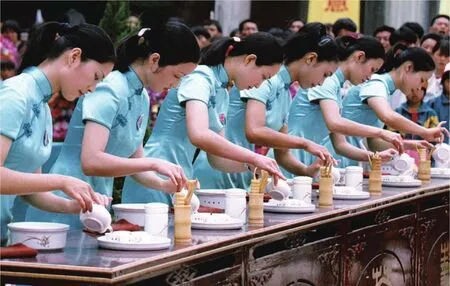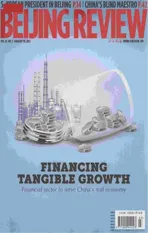A Step up for People’s Livelihoods
2012-10-16本刊编辑部
A Step up for People’s Livelihoods
Over the past 30 years, Xiamen has been carefully implementing a scientific outlook on development that is human-oriented and focused on comprehensive, balanced and sustainable development, actively advancing construction of a socialist harmonious society.When vigorously developing the economy,Xiamen has made remarkable achievements in social welfare, with the establishment of a multi-level social security system including employment, endowment, health care,education and housing.
Better education
Xiamen will implement the development strategy of “invigorating the city through science and education,” and advance balanced development of compulsory education. As for pre-school education, Xiamen promotes the establishment of a public kindergarten in each township, and as for special education, the city exempts tuition fees and gives transport and living allowances to the students. Fiscal input in education by the SEZ is continuously increasing. The city’s percapita education expenditure ranks among the top in cities of similar types of the country and province, and conditions for running schools have been greatly improved. Since 2006 Xiamen has exempted tuition and miscellaneous fees in the compulsory education period, textbook and accommodation fees for rural students in the compulsory education period and offered living allowances to poor students in urban and rural areas.Scores of college entrance examinations by students in Xiamen have ranked fi rst in the province for 10 consecutive years. The number of schools of various types and various levels rose from 595 in 1981 to 1,072 in 2010, the number of students increased from 168,400 to 692,100, the number of full-time teachers increased from 7,450 to 33,300 and the number of college graduates per 10,000 persons increased from 203 in 1982 to 1,780 in 2010.
Improved cultural services
After the establishment of the SEZ, with construction, renovation and expansion of a large amount of grassroots public cultural service facilities, Xiamen has been among the most advanced cities in cultural facilities. At the end of 2010 there were nine public libraries in Xiamen, with a total collection of 3.35 million books that had been borrowed 4.82 million times. There are eight cultural centers and four museums in the city. Xiamen has successfully hosted cultural events such as Cross-Straits(Xiamen) Cultural Industry Expo and Xiamen International Animation Festival and nurtured a lot of famous handicraft products for the cultural industry. Moreover, Xiamen pays attention to improving the international in fl uence of the city’s culture and art, successfully hosting cultural events with domestic and international influences, such as the Fourth World Choir Games, the 11th China Drama Festival and the Fourth China International Piano Competition.
In recent years, Xiamen SEZ has set up radio stations such as Xiamen News,Economy and Communications as well as music and television channels such as News,Cross-Straits and Xiamen TV. Cable TV now covers the whole island. Privately run film and television industry is developing fast, with the National Animation Base established in Xiamen. By the end of 2010, the city had offered fi ve radio channels and eight television channels, with radio coverage of 100 percent and television coverage of 98.68 percent of the city’s population.
Sports powerhouse
During the past 30 years, Xiamen has built large sports venues such as the Olympic Tennis Center, National Table Tennis Training Base, Shooting and Archery Center, Aquatic Sports Center, Soccer Training Base and Haicang Sports Center.It has installed massive fi tness trails in communities and townships and built basketball courts in the countryside. Since 2003, the city has held the Xiamen International Marathon, with the number of participants increasing from 20,000 to 80,000. The competition has become a well-known sports event and has been rated as Gold Label Road Race by the International Association of Athletics Federations. By the end of 2010 there had been 54 sports organizations and 2,967 coaches for mass sports in the city,and 50 percent of the population had participated in regular sports activities.
Top healthcare services
To satisfy the demand for health care, Xiamen has strengthened construction of the public health system, actively innovated the health care system and dispatched high-quality medical resources to communities, through which the people’s medical service conditions have been continuously improved. Medical remedy measures as well as incentive and aid mechanisms for family planning households in rural areas are implemented smoothly and the new-type rural cooperative medical system featuring comprehensive arrangement for serious diseases has been set up. In each urban neighborhood there is a standard community health care (medical) service center. A multilevel health care system covering southeast Fujian and across the Straits has been primarily established. The number of health care organizations in the city increased from 398 in 1981 to 979 in 2010, the number of medical workers increased from 3,925 to 17,800 and the number of beds in health care organizations grew from 3,302 to 10,796. By the end of 2010 life expectancy of local residents had reached 78.91 years, and major health indicators of the people are now closer to the average level of developed countries.
Urban and rural residents
Over the past three decades, people’s livelihoods in Xiamen have been comprehensively improved, realizing a historic transition from simply having enough food and clothing to leading a relatively comfortable life. With the development of the economy, urban and rural residents have more sources of income, and resident incomes have increased. The percapita disposable income of urban residents rose from 482 yuan ($76.5) in 1981 to 29,253 yuan ($4,643) in 2010, with an annual average increase of 15.2 percent; and the percapita net income of rural residents grew from 264 yuan ($41.9) in 1981 to 10,033 yuan($1,593) in 2010, growing 13.4 percent each year on average.

Local tea ceremony
The balance of savings deposits from urban and rural residents increased from 145 million yuan ($23.02 million) in 1981 to 134.67 billion yuan ($21.38 billion) in 2010,an average annual growth of 23.7 percent.Income growth has enhanced the consumption level of urban and rural residents. Resident consumption has upgraded from common durables to high-end durables such as houses,automobiles and information products, as well as individualized consumption such as education, tourism, culture and entertainment.
In 2010 the per-capita consumption expenditure of urban residents was 19,961 yuan($3,168), up 43.4 fold over 1981, with an average annual increase of 14 percent; and the per-capita consumption expenditure of rural residents was 7,532 yuan ($1,196), up 32.6 fold over 1981, with an average annual growth of 12.9 percent. The Engel coef fi cient of urban residents dropped from 60.4 percent in 1981 to 36.4 percent in 2010, and that of rural residents from 46.9 percent to 41.3 percent. Upgrading speed of household consumer goods is accelerating, and color TVs,air conditioners, mobile phones, refrigerators and washing machines have become household necessities.
Since 2000, high-end durables such as cars and computers have entered ordinary families. At the end of 2010 every 100 urban households had 151 color TVs, 237 air conditioners, 114 water heaters, 99 washing machines, 108 refrigerators, 12 video cameras, 43 sets of stereo component systems,245 mobile phones, 117 personal computers and 23 cars; and every 100 rural households had 115 air conditioners, 107 refrigerators,96 water heaters, 62 washing machines, 52 personal computers, 246 mobile phones,147 motorcycles and 10 cars.
Xiamen SEZ has made huge achievements in economic and social development and has entered a stage of accelerated urbanization. At this new historic point, the SEZ will adhere to the scientific outlook on development, adapt to the new changes of domestic and international conditions,adhere to reform and opening up, coordinate development of urban and rural areas, and ensure China’s peaceful reuni fi cation in an all-round way.
